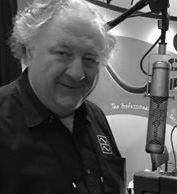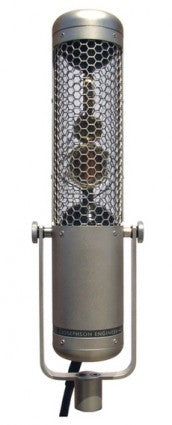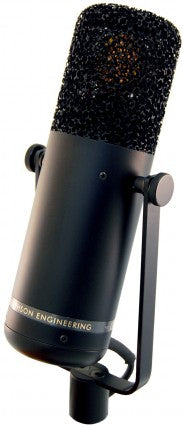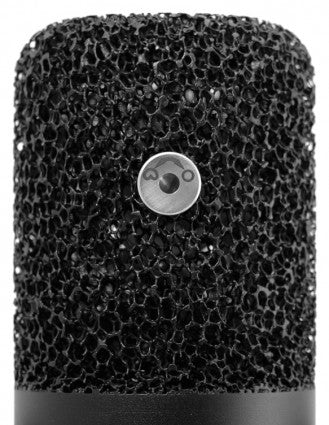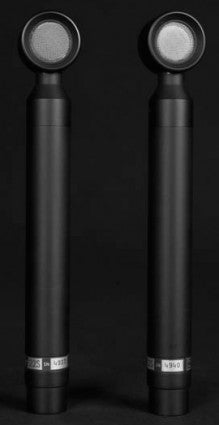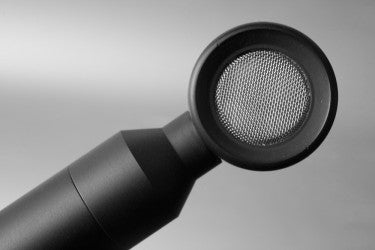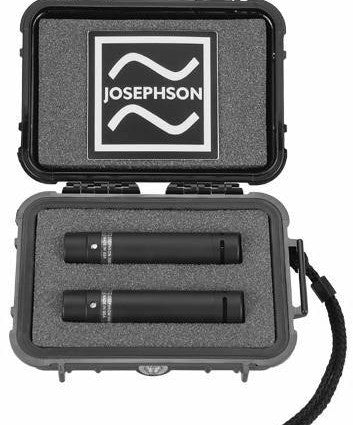Designer talk : David Josephson | Josephson Engineering
David Josephson is the man behind the name and brand of some of the most sought after, precise and detailed musical microphones available. Based in Santa Cruz and with over 25 years of designing and making microphones, I caught up with him for chat about his unique products and thoughts behind Josephson Engineering.
KMR Audio: Prior to starting in 1988, I know that you worked with Geophysical Surveying Instrumentation equipment. Has music and recording always been a passion of yours, and was it this grounding in another industry that encouraged you to start Josephson Engineering ?
Yes, always. I grew up in Berkeley and did some engineering at the Community Radio Station KPFA there from age 11, then chief engineer of the University of California radio station while I was a student there in the 70s. Geophysics was a way to get paid for difficult and fun electronics as I was not interested in the studio scene at the time, or TV audio, where I had job offers. When you are measuring the earth’s magnetic field as you fly over it to a precision of a few parts per billion, and you’re on an airplane that makes all sorts of magnetic fields of its own, you have some interesting challenges! I like interesting challenges…
KMR Audio: Is that something you’re still interested in?
I’m still peripherally involved in aviation, as we also work in precision sound measurement. I’m giving a talk tomorrow at a NASA symposium on new aircraft designs that have to be perceived as really quiet in order to be used by people inside the community rather than at a distant airport. You don’t need a flying car if you can land in your yard without disturbing your neighbors. My colleagues and I are really focused on critical listening, and sometimes the physics-based people need some help to understand that the numbers have to represent what people perceive, not the other way around.
KMR Audio: I know that many designers start out of necessity as they need certain pieces of equipment, so was it the same with microphones in your case?
I could borrow recorders, I could build mixers. I couldn’t beg, borrow or afford good microphones. I thought I could make better tools than were available, particularly some of the main ones.
KMR Audio: What was the first mic that you designed, and how did it come about – is this still a design you use today?
The C700S was the first. I had done this approach years before with ribbons and dynamics, but once I figured out how the Siemens/AKG multi-chambered capsule worked, it was time to make some and launch that product. That came about as part of an OEM project for Manley Labs, they knew the capsule was a particularly good large diaphragm condenser design and wanted to base a microphone on it. It took about four years of experiments to figure it out, using several examples of the several different manufacturing variants that were tried.
KMR Audio: I use a C700S regularly and it’s probably one of the best sounding acoustic guitar microphones I’ve used. The 3 capsules it has with the Figure 8 facing is so useful for Mid Side recordings, what was the thinking behind the 7 Series?
Just that people wanted one microphone they could use for everything. I thought it wasn’t possible but I think we’re pretty close.
KMR Audio: The C715 with the single diaphragm and the C716 with the dual-diaphragm are obviously mics in their own right, but leaning from the C700A and C700S. How did you create the ‘aluminium foam’ design around these mics to not add any internal reflections and make the mic sound so smooth?
The aluminium foam material is made near here by a company that mostly supplies military aircraft manufacturers. It’s used to stabilize fuel in a tank so it doesn’t slosh around in high-G manoeuvres.
KMR Audio: What was the thinking behind that concept?
The thinking was that good sound is often the absence of bad sound, and reflections inside a grill are usually bad. We couldn’t eliminate them entirely, but by making the grill diffuse so the reflections are spread out over a thickness of very open material, we can greatly reduce their impact.
Particularly for studio mics used at short distances (where pressure gradient is much greater than mics used at longer distances) reflections from the basket have always been a problem. Sometimes they define a signature sound of a microphone but once you listened to a capsule without the reflecting structure around it, you don’t want to go back.
Many common large diaphragm mic grilles, because of their dimensions, have sharp resonances in the sibilance region of human voice, roughly 4 to 9 kHz. Sound in these frequencies echoes around inside the basket, causing the nasty harshness that many people hear, even in some classic mics. It’s not just brightness that can be fixed with EQ, it’s in the time domain and will always be in the track. This is the primary problem that the metal foam grille was designed to avoid.
KMR Audio: What is your proudest achievement in your designs to date?
Not sure…maybe that with the team effort of the other folks here, or that the C700S is even better than it was 20+ years ago is really significant.
KMR Audio: The Series Six range includes the popular FET e22s mic that I believe was originally designed in conjunction with Steve Albini. Who approached whom, and did this mic achieve the desired result or exceed your expectations ?
Steve asked me whether we could make something that would replace some right-angle condenser cardioids that were no longer in production. We went through about six iterations and more importantly than mine, the e22S seemed to exceed his expectations.
KMR Audio: I’ve used the e22s on guitar cabinets extremely successfully yet weren’t they originally designed for drums?
They were. But the attributes that make them useful for drums : high overload point, freedom from pattern distortion when used up close, clean handling of off-axis sounds all work with any close-up application. It has surprised us that people use them as go-to mics for piano, even under a closed lid which is often a disaster with other mics, but they really work for that.
KMR Audio: How do you go about creating a new design? Is it from user feedback or do you constantly have ideas flowing about, and then try and put them into some product ideas? What is the mindset of Josephson Engineering and how hands-on are you in the process?
Hands on 100%. We try to focus on doing things that other mic companies can’t or don’t want to do. We like the difficult challenges. When we sell direct from us to a dealer who sells to the end-user, rather than through several distribution steps, we can afford to put more of the buyer’s cash into the actual product, and our mics are not cheap to make. We listen to our dealers, who we hope listen to our end-users, and routinely ask the question, “what kind of mic do you need that doesn’t exist today?”
KMR Audio: How many people do you have working at Josephson, and are all mics made / designed in house ? – I know you make some OEM capsules for others so I presume it’s all in house?
We have four fulltime and four part-time people, plus about a dozen critical subcontractors, most of them within about 50 miles of us. We are all craftspeople who really care about the work.
All mics are designed by me with input from the other two principals of the company, Kelly Kay and Dave Gordon, and are all made in-house. The other fulltimer is David Stepka, who used to build pipe organs (fulltime.) Some of our part-timers used to build high density disk drives (when they were made locally, by hand) and dental appliances. All of these people are even more detail-oriented than I am.
The circuit boards are stuffed about six blocks from our shop. The machining is mostly done in Santa Cruz and Silicon Valley by small shops who usually make surgical implant parts, radar and x-ray tube parts, racing car parts and stuff like that.
Our rugged black chrome plating is done in Chicago because it’s too demanding to meet the environmental protection requirements in California. Most of our semiconductors come from Japan, our transformers come from Sweden. The diaphragm film and its gold layer are made here in the US. Unfortunately we can’t use a lot of off-the-shelf parts and most are custom made for us.
KMR Audio: I know you have been heavily involved with the AES Organisation for many years, including Governor in 2009-2011. Do you think it’s important that we continually strive for Audio Excellence when we’re constantly being told that everything is being ‘dumbed down’ to the mp3 generation?
Yes. Maybe the science is being dumbed down, but the artistic options are open to a wider range of people who are in turn able to make interesting music and sounds who never had access to this medium before, and we’re here to make tools for them. I’m still involved in the Standards Committee of the AES, where we are trying to get people to derive consensus on how they will measure and connect things.
KMR Audio: I feel that it’s never been as good a time to make and record music, and the tools available are better than ever.
Exactly.
KMR Audio: What music do you like listening to yourself? – And has this influenced your microphone designs based upon the types of music you’ve enjoyed listening to, and what was used on the recordings ?
I don’t really like recorded music much, prefer live, but there are exceptions. I listen to things that are challenging to record and offer unique sound experiences. I’ve recorded mostly experimental/new classical music and jazz, and listen to that, also bluegrass. Also classic pop recordings when it was new for people..when the toolset was limited and people realised what they could do with playing a sax into a piano, or layering backup vocals so it sounded like an orchestra. This requires listening rather than looking at meters or graphs.
KMR Audio: The C42 cardioid FET mic is popular here in the UK, I know many producers and engineers who use it on acoustic guitar and drums, especially as they’re available as matched pairs. What made you design and come up with this mic?
I wanted to offer a basic studio-utility cardioid for people who could no longer get their favorite old German small diaphragm mics that were no longer made. I knew I had to find a way to make it sonically neutral and be affordable. There are some tricks in that C42 capsule that people don’t see, and buy us a lot of practical performance.
KMR Audio: Whilst the price is affordable the microphone definitely isn’t low quality, personally I think it feels and sounds like it should be twice the price when I demo it to clients, how do you achieve quality within a budget?
By limiting how far we reach in specsmanship, and concentrate instead on how it sounds. It has a bit more of a presence boost than I would like, and rolls off a bit between 18 and 20 kHz. It doesn’t pretend to have single-digit noise floor. But that’s a good tradeoff if it still sounds neutral off-axis ( which is really hard for some designers) – You’re free to sell it for double if you like!
KMR Audio: Is there anything you would like to have invented, or something that you look at these days and go hmmm, that’s pretty good?
I would like to find time to build some of the things I have invented and haven’t had time to make. There is a new microphone topology unlike anything else that’s ever been made, with an intrinsically digital output at any desired sampling rate or format ( DSD or PCM, doesn’t matter ). No further details than that, sorry, but it’s why I did so much work on the AES42 digital microphone interface – so there would be such a thing that I could plug my design into once made.
KMR Audio: Your Lab / Studio is burning down, what 3 things would you save and why?
Not things – every thing can be recreated.
I would be sure the people got out. We have gone to extraordinary efforts to perfect some of our capsule manufacturing processes, both in conditioning the material, making it stable over time and repeatable. But there are three of us who know these processes, they’re not magic, and we could replicate them again anywhere, given some time and decent machinists.
KMR Audio: Do you have any new products or designs in progress?
There is a new microphone that we’re shipping this Spring, that uses a vacuum tube. People have asked us for a “tube mic” and trying to figure out what they really wanted we have created a multipattern mic using a single dual-diaphragm mic like the one we use in the C700 and C716. But instead of a cascode front-end that uses two FETs like most of our other mics, it uses one FET and one tube.
This gets away from some of the noise penalty of using the tube to interface to the capsule directly.
KMR Audio: Thanks David so much for the interview.
Thank you!
FONTE: https://www.kmraudio.com/news/designer-talk-david-josephson-josephson-engineering/
Julian Ludwig é diretor do Pro Áudio Clube, produtora de áudio Jacarandá, Loc On Demand e Jacarandá Licensing. Trabalhou para empresas como: Guaraná Antartica, TV Gazeta, NET, Chivas Regal, FNAC, Prefeitura de São Paulo, Mukeca Filmes, Agência LEW’LARA TBWA, Agencia MPM, Agência Content House entre outras. Fez trilhas para programas de TV como: Internet-se (Rede TV), Você Bonita (TV Gazeta), Mix Mulher (TV Gazeta), Os Impedidos (TV Gazeta), Estação Pet (TV Gazeta), CQC (TV Band) Vinheta Oficial TV Gazeta, entre outras. Também atuou em vários longas e curtas metragens, incluindo mixagem em 5.1 e serviços de pós-produção.


